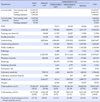Abstract
Purpose
The purpose of this study was to identify nursing service costs associated with all health care costs incurred by the institution.
Methods
This study was an empirical case study research in which the nursing cost was separated from total medical cost. The nursing cost index was calculated through a cost allocation method after summarizing costs for personnel, raw materials and administration of each department in one public hospital. The 2014 budget plan, published in ‘Public Hospitals Alert’, was used as data and the data were analyzed using the Microsoft Office EXCEL 2013 program.
Results
When comparing total medical costs and nursing costs, the nursing cost were 27.14% of the total medical cost. The nursing cost per nurse per hour was calculated as ₩29,128 The nursing cost per inpatient per day was calculated as ₩157,970, and the administration cost per patient was calculated as ₩133,710.
Figures and Tables
References
1. Aiken LH, Clarke SP, Cheung RB, Sloane DM, Silber JH. Educational levels of hospital nurses and surgical patient mortality. JAMA. 2003; 290:1617–1623.
2. Kim J, Kim S, Park B. Alternative strategies of nursing fees differentiation policy in the national health insurance. Seoul: Seoul National University & Korean Nurses Association;2011.
3. Kim JY, Park BH, Ko YK. The status nursing care delivery system and the influencing factors on quality of nursing care. Korean J Hosp Manag. 2016; 21(2):24–36.
4. Ko YK, Kim BJ. An analysis of nurse staffing level and nursing performance in the general unit. J Korean Acad Nurs Adm. 2008; 14(4):413–420.
5. Kim S, Kim J. A proposal to improve nursing fee differentiation policy for general hospitals using profitability-analysis in the National Health Insurance. J Korean Acad Nurs. 2012; 42(3):351–360. DOI: 10.4040/jkan.2012.42.3.351.
6. Kim YM. Development plan of differentiated inpatient nursing fees by staffing grades. Paper presented at: Spring Conference of Korean Academy of Nursing Administration. June 31, 2013; Chonnam National University. Gwangju:
7. Health Insurance Review & Assessment Service. Health Insurance Payroll Costs. Feb. 2016 ed. Seoul: Health Insurance Review & Assessment Service;2016.
8. National Health Insurance Service (KR). National Health Insurance Fee [Internet]. cited 2017 February 7th. Available from: http://www.nhis.or.kr/.
9. Oh DI, Kang KW, Lee YT, Jung YH. A study on inpatient cost analysis and optimum level by medical institution type. . Seoul: Sangmyung University. Medical care cost research team;2006. 02.
10. Park SK. Survey on hospital admission environment: focused on hospitals and clinics. KHIDI Brief. 2013; 61:1–8.
11. Moon WC. A study on construction of the hospitals' cost-accounting system for rational computation of the charge for medical care insurance. [mater's thesis]. Gwangju: Gwangju University;2000.
12. Choi JH. Hospital management and cost accounting. Daegu: Daemyung;2000.
13. Lim JY. The trends of cost analysis on nursing services and empirical study. [mater's thesis]. Seoul: Korea University;2007.
14. Shin HS, Ahn ES. Major dental service activity cost of National Health Insurance. Korean J Manag Account Res. 2014; 14(1):85–107.
15. Park GH, Yang DH. An empirical study of the overhead cost drivers; the case of the tertiary hospitals. Korean Account Rev. 1998; 23(2):163–181.
16. Seol DJ, Lee KT, Lee HJ, Chung CA. Empirical analysis of overhead cost drivers in the South Korea hospitals. Korean J Health Policy Adm. 2000; 10(4):116–143.
17. Macarthur JB, Stranahan HA. Cost driver analysis in hospitals: A simulation equation approach. J Manag Account Res. 1998; 10:279–312.
18. Park SA, Jung MS, Kim JH, Kim JK, Joo MK, Park SH, Yoo M. Nursing management: nursing administration and policy. Seoul: Koonja;2010.
19. Cho SY, Park JH. Development of a nursing fee schedule model. J Korean Acad Nurs. 1993; 23:68–89.
20. Park J, Hwangbo S, Lee E. Identification activities for determination of nursing cost. J Nurs Acad Soc. 1992; 22:185–206.
21. Ryu H, Jung K, Lim J. Test on the cost and development on the payment system of home health care nursing. J Korean Acad Nurs. 2006; 36:503–513.
22. Kim J, Park S, Kim M, Sung Y, Park K, Kim Sl, et al. The effect of nursing grades on a hospital's financial performance in nursing fees differentiation policy. Seoul: Seoul Nurses Association;2009.
23. Kim JH, Kim MA, Kim MW, Kim KS, Yoo CS. Development of a resource-based relative value scale and its conversion factor for advanced nursing practices in the National Health Insurance. J Korean Acad Nurs. 2011; 41(3):302–312. DOI: 10.4040/jkan.2011.41.3.302.
24. Park JH, Song MS, Sung YH, Cho JS, Sim WH. Estimation of nursing costs for hospitalized patients using the resourcebased relative value scale. J Korean Acad Nurs Adm. 1999; 5(2):253–280.
25. Jung HS, Lee BI. Economic evaluation of a workplace occupational health nursing service: Based on comparison with atmospheric environment managing engineer. J Korean Acad Nurs. 2013; 43(4):507–516. DOI: 10.4040/jkan.2013.43.4.507.
26. Shin YC, Shin HW, Ryu GC, Shin HS, Park S, Kim JH, et al. Accounting survey by the type of medical institution for improving relative value. June 4. 2012; Conference room in Korea Institute for Health and Social Affair. Seoul:




 PDF
PDF ePub
ePub Citation
Citation Print
Print







 XML Download
XML Download